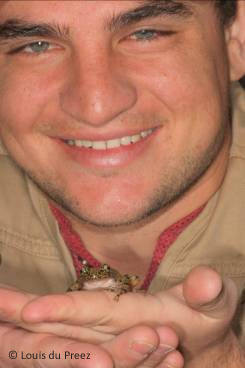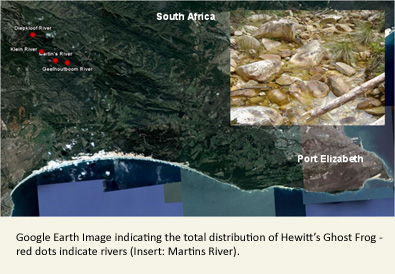The second of our Fellows for EDGE amphibian species, Werner Conradie, tells us about the Critically Endangered frogs he is studying in South Africa.
As a young enthusiastic herpetologist it is my privilege as an EDGE Fellow to work on one of the EDGE’s focal species, the ghost frogs.
The ghost frogs (family Heleophrynidae) are endemic to South Africa, Swaziland and Lesotho and are considered to be the most primitive leptodactyloid frogs. Ghost frogs diverged from all other amphibians 160 million years ago, and are thus evolutionary distinct from any other amphibian species. Their closet relatives are found in Australia and South America. This is a small family comprising of only six species, off which two are critically endangered; Hewitt’s ghost frog (Heleophryne hewitti) and Rose’s ghost frog (Heleophryne rosei).
My main focus will be on Hewitt’s ghost frog. They are secretive species and aren’t seen everyday. Visits to the type locality, Geelhoutboom River, during September 2008, revealed the first sight of a gravid (carrying eggs) Hewitt’s ghost frog since 2000. Although adults aren’t seen that often, tadpoles are present throughout the year and have an extended larval stage of approximately two years. Not a lot is known on breeding and non-breeding behavior of these species.
They are restricted to the headwaters of only four rivers (Geelhoutboom-, Martins-, Klein- and Diepkloof River) in the Elandsberge, comprising of distance of 10 km. All these rivers are found in the Longmore Plantation run by Mountain to Ocean (MTO). Although none of the rivers are protected, they are under the management of MTO and are being monitored.
During the study we want to asses the impact of the forestry activities on the ghost frog, chytridiomycosis screening, radio telemetry tracking and developing a monitoring technique for adult populations. We will also go in search of new populations. In the end we want to put this all together and compile a conservation action plan that will ensure the survival of this species. What we learned through our study with Hewitt’s ghost frog we will apply to Rose’s ghost frog, that are under more threat than Hewitt’s ghost frog.
If you would like to support EDGE projects, including Werner’s research, then please become an EDGE Champion or donate here.


